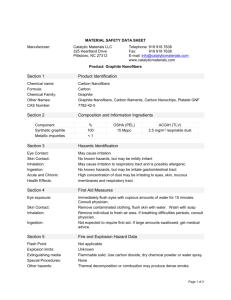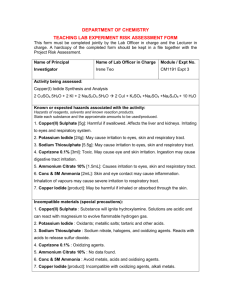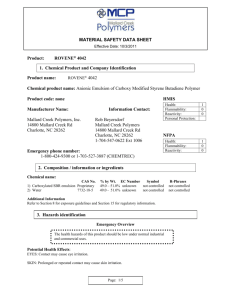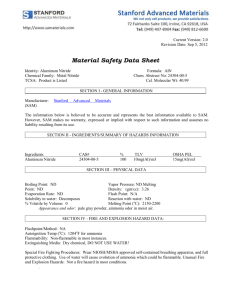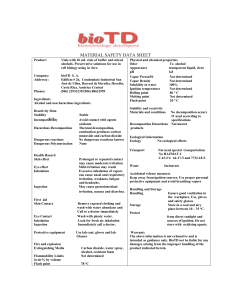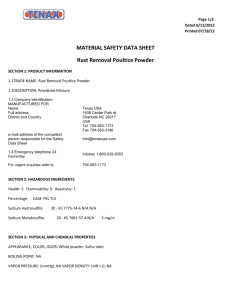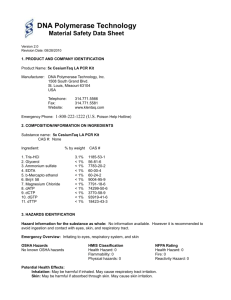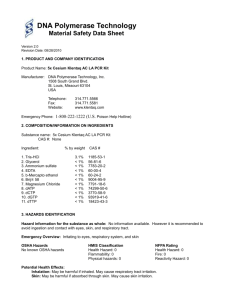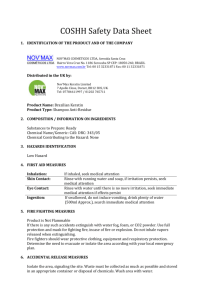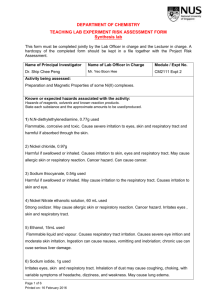Hazardous Chemical Fact Sheet
advertisement
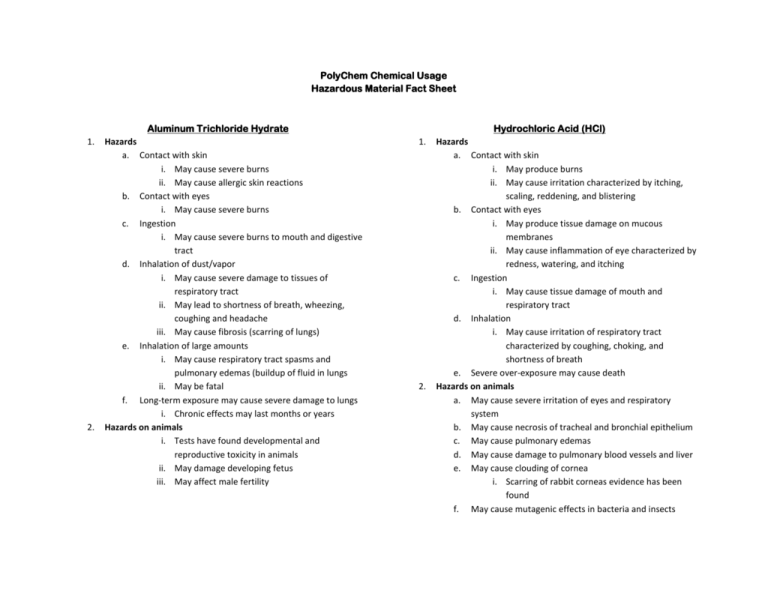
PolyChem Chemical Usage Hazardous Material Fact Sheet 1. 2. Aluminum Trichloride Hydrate Hazards a. Contact with skin i. May cause severe burns ii. May cause allergic skin reactions b. Contact with eyes i. May cause severe burns c. Ingestion i. May cause severe burns to mouth and digestive tract d. Inhalation of dust/vapor i. May cause severe damage to tissues of respiratory tract ii. May lead to shortness of breath, wheezing, coughing and headache iii. May cause fibrosis (scarring of lungs) e. Inhalation of large amounts i. May cause respiratory tract spasms and pulmonary edemas (buildup of fluid in lungs ii. May be fatal f. Long-term exposure may cause severe damage to lungs i. Chronic effects may last months or years Hazards on animals i. Tests have found developmental and reproductive toxicity in animals ii. May damage developing fetus iii. May affect male fertility 1. 2. Hydrochloric Acid (HCl) Hazards a. Contact with skin i. May produce burns ii. May cause irritation characterized by itching, scaling, reddening, and blistering b. Contact with eyes i. May produce tissue damage on mucous membranes ii. May cause inflammation of eye characterized by redness, watering, and itching c. Ingestion i. May cause tissue damage of mouth and respiratory tract d. Inhalation i. May cause irritation of respiratory tract characterized by coughing, choking, and shortness of breath e. Severe over-exposure may cause death Hazards on animals a. May cause severe irritation of eyes and respiratory system b. May cause necrosis of tracheal and bronchial epithelium c. May cause pulmonary edemas d. May cause damage to pulmonary blood vessels and liver e. May cause clouding of cornea i. Scarring of rabbit corneas evidence has been found f. May cause mutagenic effects in bacteria and insects 1. 2. Chromium Hazards a. Contact with skin i. May cause skin allergy and asthma-like allergy ii. May cause burns, blisters, and deep ulcers with prolonged contact iii. May cause irritation caused by dermatitis b. Ingestion i. May cause damage to liver and kidneys c. Inhalation i. May cause irritation in nose and throat 1. May cause sores and/or holes in septum dividing inner nose ii. May cause flu-like illness called Metal Fume Fever Hazards on animals a. Fish i. May cause damage to gills, gonads, heart, kidney, liver, scales, and skin b. Rabbits and Guinea Pigs i. May cause mutations and malignancy ii. May cause damage to kidney, heart, spleen, and brain iii. May cause skin lesions or ulcers in guinea pigs c. Birds i. May cause damage to eggs, liver, kidney, and feathers ii. May cause deformities characterized by short and twisted limbs and growth stunt 1. 2. Benzene Hazards a. Contact with skin i. May cause drying and scaling of skin b. Contact with eyes i. May cause irritation of eyes c. Inhalation i. May cause leukemia because of carcinogenic effecs ii. May cause irritation of nose and throat iii. May cause headache, dizziness, nausea and vomiting d. High/repeated exposure i. May cause convulsions, coma, or sudden death ii. May cause aplastic anemia (damage to blood cells) Hazards on animals a. May cause abnormal prenatal development b. May cause bone marrow damage c. May cause changes in circulating blood cells d. May cause alterations in immune response e. May cause cancer 1. 2. Sulfates Hazards a. Contact with skin i. May cause itching and eczema b. Contact with eyes i. May cause damage to eyes ii. May cause conjunctivitis iii. May cause inflammation of eyelid lining iv. May cause excess fluid buildup in eyelid c. Ingestion i. May cause vomiting ii. May cause metallic taste in mouth, burning pain in chest and abdomen, intense nausea, diarrhea, headache, sweating, and shock iii. May cause injury to brain, liver, kidneys, stomach, and intestinal lining d. Chronic effects may cause anemia Hazards on animals a. May cause inflammation of gastrointestinal tract b. May cause symptoms of abdominal pain, vomiting and diarrhea c. May cause death in guinea pigs and rabbits d. May cause starvation e. May cause absence of appetite, anemia, and degenerative changes followed by death f. May cause reproductive effects including testicular atrophy in birds, interruption in sperm production and abnormal prenatal development g. May cause heart disease h. May cause toxicity in fish i. Poisonous to fish ii. May cause decrease in populations of aquatic invertebrates, plants, and fish 1. 2. Nitrates Hazards a. Contact with skin i. May cause irritation b. Contact with eyes i. May cause irritation c. Ingestion i. May cause abdominal pain, nausea, vomiting, diarrhea d. Inhalation i. May cause irritation of nose, throat, and mucous membrane ii. May cause coughing, severe lung congestion, and difficulty breathing Hazards on animals a. Aquatic animals i. May cause slower maturation in fish ii. May cause lower reproductive success iii. May cause death iv. May cause reduced size in frog tadpoles b. May cause nitrate poisoning in livestock i. Characteristics of poisoning include; discoloring of nonpigmented areas or mucous membranes; sluggish or staggering gait; rapid heartbeat; convulsion; coma and death

